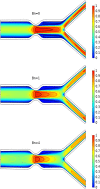Fluid structure interaction study of non-Newtonian Casson fluid in a bifurcated channel having stenosis with elastic walls
- PMID: 35851297
- PMCID: PMC9293974
- DOI: 10.1038/s41598-022-16213-3
Fluid structure interaction study of non-Newtonian Casson fluid in a bifurcated channel having stenosis with elastic walls
Abstract
Fluid-structure interaction (FSI) gained a huge attention of scientists and researchers due to its applications in biomedical and mechanical engineering. One of the most important applications of FSI is to study the elastic wall behavior of stenotic arteries. Blood is the suspension of various cells characterized by shear thinning, yield stress, and viscoelastic qualities that can be assessed by using non-Newtonian models. In this study we explored non-Newtonian, incompressible Casson fluid flow in a bifurcated artery with a stenosis. The two-dimensional Casson model is used to study the hemodynamics of the flow. The walls of the artery are supposed to be elastic and the stenosis region is constructed in both walls. Suitable scales are used to transform the nonlinear differential equations into a dimensionless form. The problem is formulated and discretized using Arbitrary Lagrangian-Eulerian (ALE) approach. The finite element method (FEM) technique is used to solve the system of equations, together with appropriate boundary conditions. The analysis is carried out for the Bingham number, Hartmann number, and Reynolds number. The graphical results of pressure field, velocity profile, and load on the walls are assessed and used to study the influence of hemodynamic effects on stenotic arteries, bifurcation region, and elastic walls. This study shows that there is an increase in wall shear stresses (WSS) with increasing values of Bingham number and Hartmann number. Also, for different values of the Bingham number, the load on the upper wall is computed against the Hartmann number. The result indicate that load at the walls increases as the values of Bingham number and Hartmann number increase.
© 2022. The Author(s).
Conflict of interest statement
The authors declare no competing interests.
Figures












References
-
- Sankar DS. Two-phase non-linear model for blood flow in asymmetric and axisymmetric stenosed arteries. Int. J. Nonlinear Mech. 2011;46:296–305. doi: 10.1016/J.IJNONLINMEC.2010.09.011. - DOI
-
- Cokelet GR. The rheology of human blood. In: Fung YC, editor. Biomechanics. Englewood Cliffs: Prentice-Hall; 1972. pp. 63–103.
-
- Pontrelli G. Pulsatile blood flow in a pipe. Comput. Fluids. 1998;27:367–380. doi: 10.1016/S0045-7930(97)00041-8. - DOI
MeSH terms
LinkOut - more resources
Full Text Sources
Research Materials

